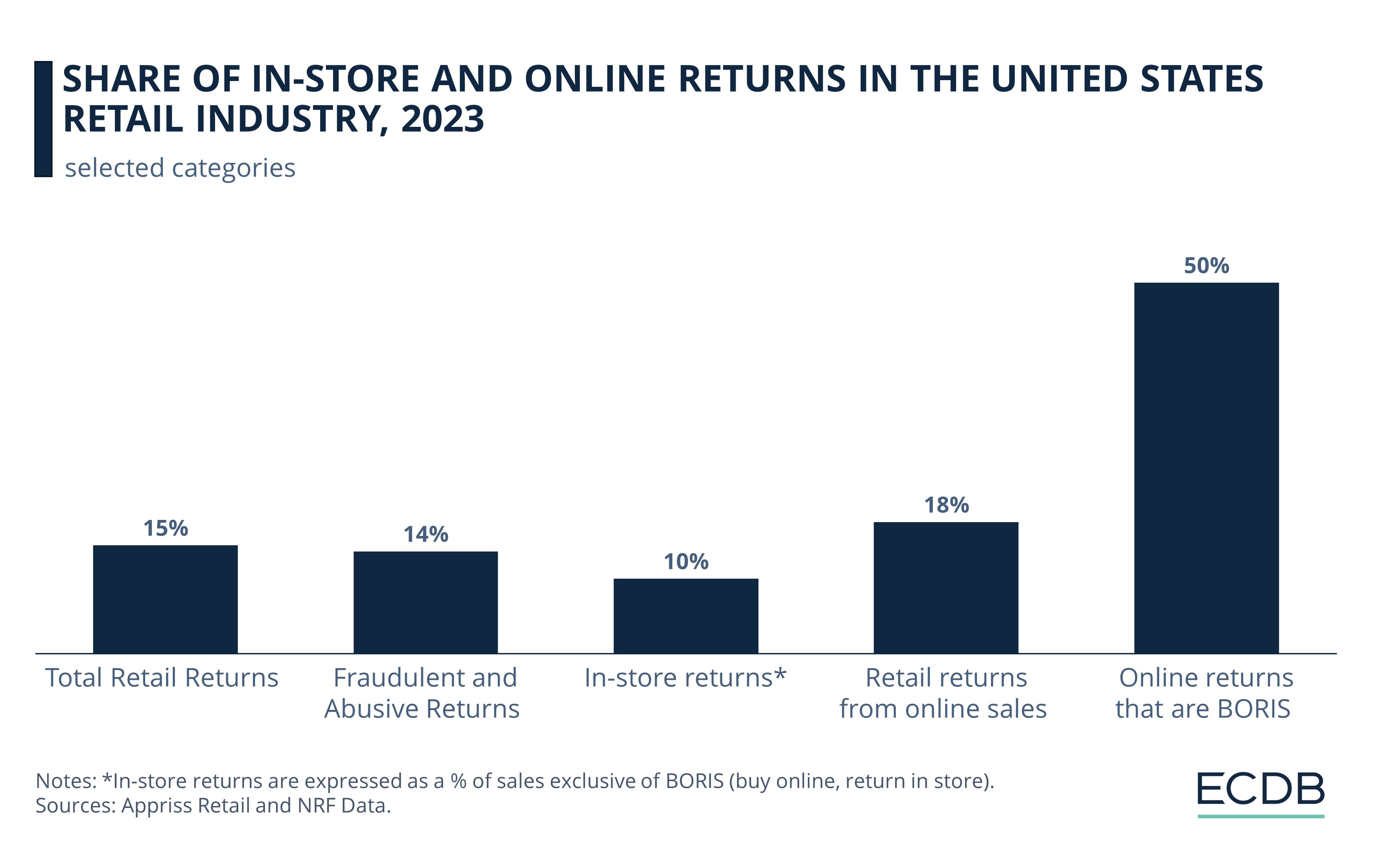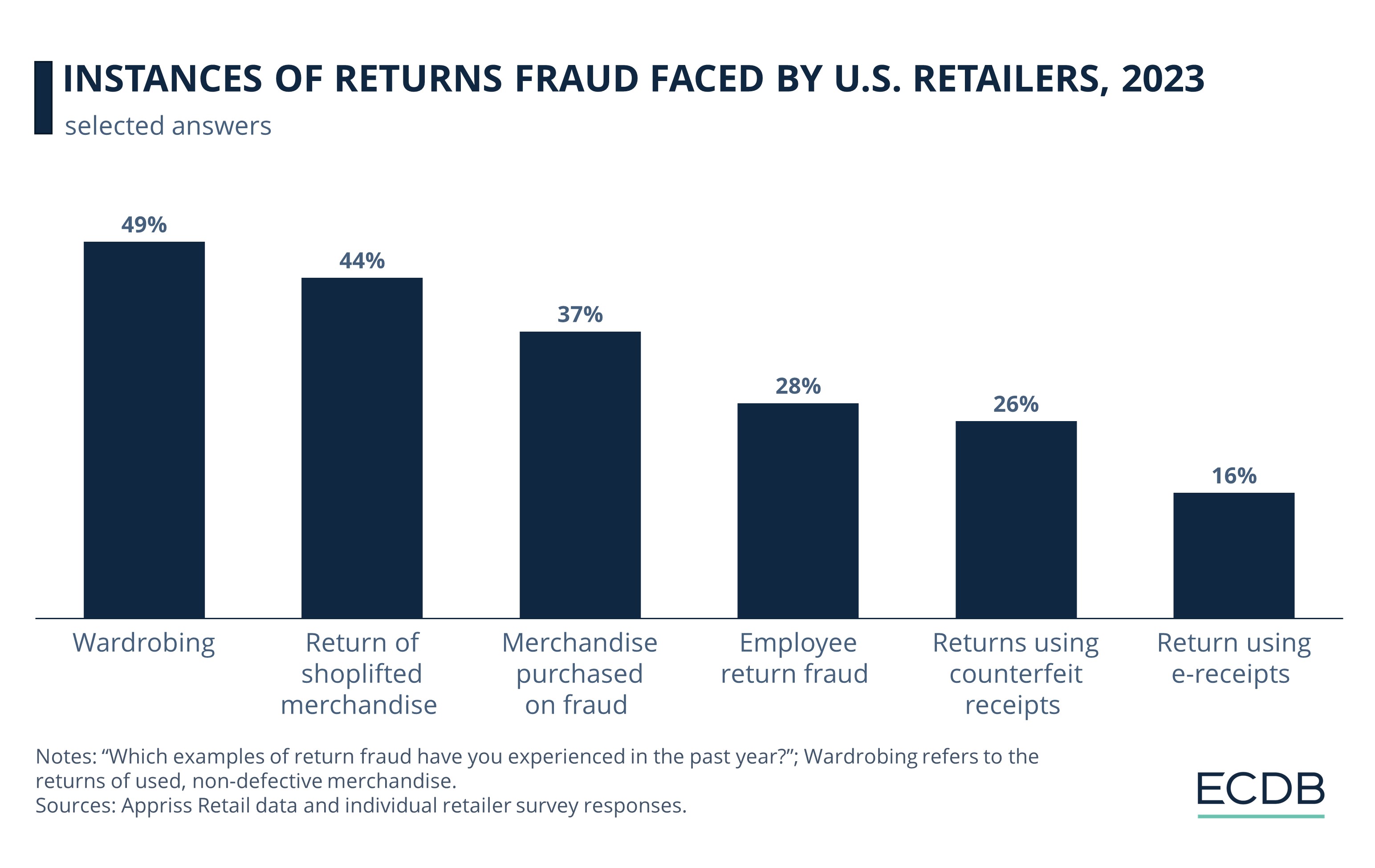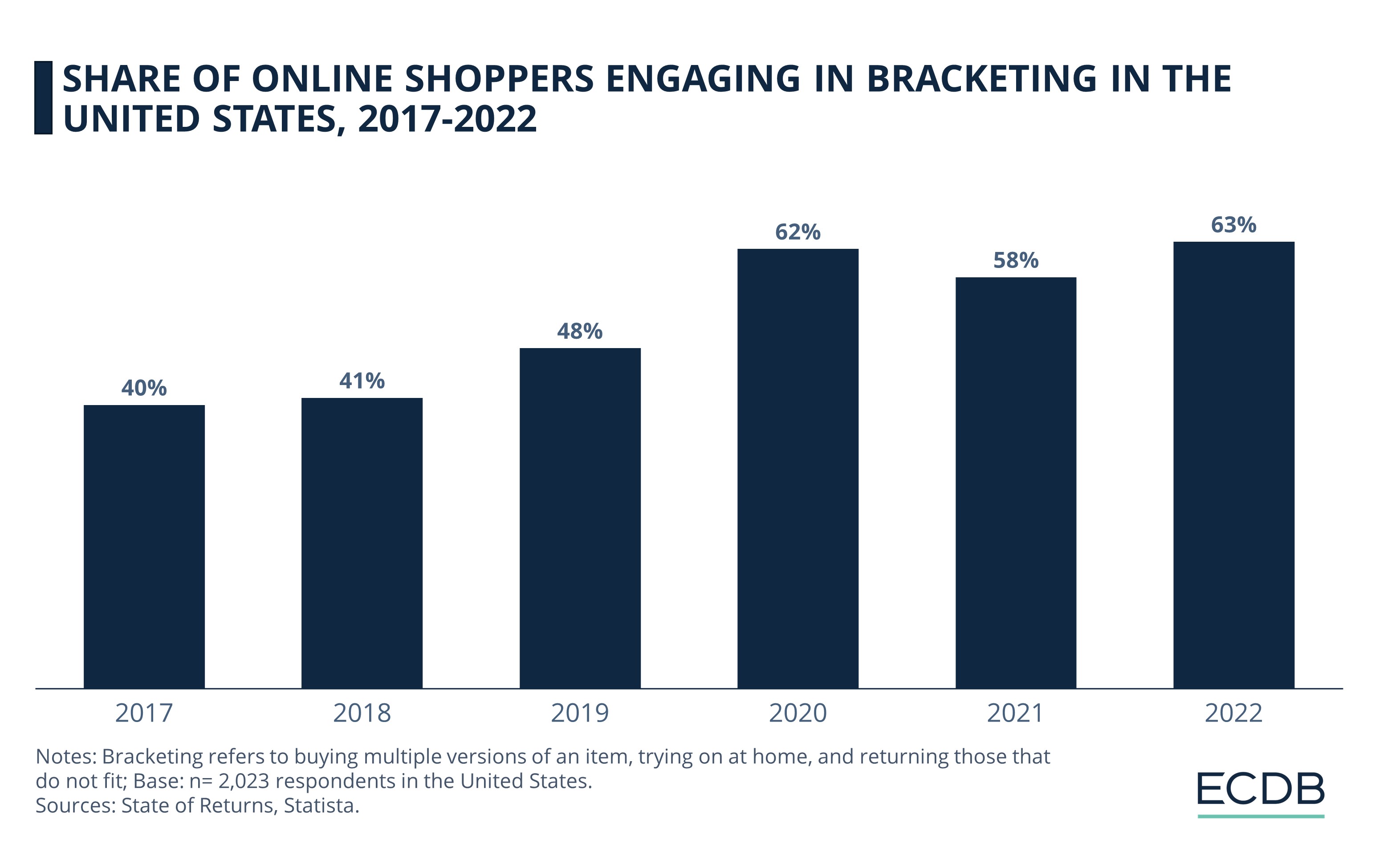ECOMMERCE: LOGISTICS
Reverse Logistics: Fraudulent Returns in the United States, Industry Trends
Within retail returns, the increase in fraudulent returns is a worrying trend: it cost U.S. retailers US$101 billion in 2023. Find out the most prevalent types of returns fraud and key trends in the returns market, including AI use and sustainability concerns.
Article by Nashra Fatima | April 29, 2024Fraud in Reverse Logistics: Key Insights
Cost of Returns Fraud: In 2023, fraudulent or abusive returns accounted for 14% of all retail returns. This amounts to a cost of US$101 billion.
Types of Returns Fraud: Nearly half of all U.S.- based retailers have reported facing returns fraud from Wardrobing. Return of shoplifted items is the second most occurring form of return abuse, followed by return of products obtained by fraud.
Industry Trends: Some key trends in reverse eCommerce logistics include the use of Artificial Intelligence in returns management, bracket buying, and sustainability concerns.
With the growth of the reverse logistics market, instances of fraudulent returns are also increasing.
As companies scramble to reduce returns, discussions of returns management and environmental impact take center stage. The process of returns remains fraught with complexities different than the forward supply chain.
Despite the measures retailers are taking, fraudulent returns are increasing. Find out the most frequent types of returns fraud in the United States, alongside the notable trends in the returns industry with regards to online retail, AI use, and sustainability
Returns Fraud in the United States: 14% of all Retail Returns Are Fraudulent
According to the National Retail Federation (NRF), fraudulent returns in the United States amounted to US$101 billion in 2023.
In terms of percentage, fraudulent returns constituted 14% of all retail returns made last year.

By the end of 2023, retailers projected that fraudulent returns would increase to make up 16.5% of all returns in the U.S.
Retailers report that shoppers are taking up different types of fraud to make returns. The practice of Wardrobing took the lead over others in 2023.
“Wardrobing” is the Most Common Type of Returns Fraud
The most frequent type of return fraud that retailers face in the United States is Wardrobing. This refers to the practice of buying a product, using it, and then returning it for a full refund – akin to using the item like a rental but without paying.
In 2023, nearly half of all retailers surveyed (49%) have faced returns from Wardrobing.

The second most frequently occurring fraudulent practice is the return of shoplifted items, at 44%. Return of merchandise purchased by fraud stands third, with 37%. This involves using fraudulent means to obtain a product – for example, using stolen credit card information – and then returning it to the retailer for a refund, exchange, or store credit.
16% of retailers also reported fraud through e-receipts or counterfeit online purchase confirmations. Fraudsters may unlawfully get e-receipts of products bought online by genuine customers, then attempt in-store return of items that they never purchased. It works when stores have a policy of accepting refunds through an e-receipt without requiring the item to be present.
Fraudsters can also tamper with an online receipt to make fraudulent returns. They may also engage in multiple redemption – that is, using the same e-receipt to make multiple returns at different locations. Poor system connectivity between stores facilitates this practice.
Per NRF, the fastest growing category in fraudulent returns is claims and appeasements. In eCommerce, this refers to false claims about the order not being delivered or arriving damaged. As appeasement, retailers may offer a full refund or credit – thus incurring loss.
Trends in Returns: Automation with AI, Bracketing, Sustainability Concerns

Below, we discuss three notable trends in returns, specifically as they relate to eCommerce.
These include the use of AI for managing returns, the practice of bracket buying, and sustainability issues plaguing online returns.
Artificial Intelligence: Automation in Returns Management
Artificial intelligence (AI) is being increasingly adopted in eCommerce. In returns management, AI can be used to analyze consumer behavior on websites and predict return rates. AI extracts actionable insights from customer reviews and returns communications, analyzes return patterns, and helps detect fraud.
Retailers can use AI to find the cheapest route and automatically track returns. Real-time data can help examine product conditions and calculate costs for processing, transportation, storage, and resale.
Stores have begun using AI to optimize returns. The Wall Street Journal reports H&M’s use of AI for targeted ads. Through AI, they analyze consumer behavior and direct certain ads only to consumers found less likely to make returns.
Others like Amazon UK are utilizing AI to generate accurate product descriptions and track customers who make frequent returns to limit their exposure to certain ads.
Bracketing: Online Consumer Behavior or Returns Abuse?
In its report, the NRF hints at “bracketing” as a kind of returns abuse. Also called buy-try-return and similar to Wardrobing, this practice refers to the act of purchasing several versions of the same item, with variations in color or size, with the intention to return some of them.
Online consumers are found particularly inclined to engage in bracketing. According to State of Returns, 63% of online shoppers in the United States said that they bracket bought in 2022.

From a consumer’s perspective, bracketing may not strictly qualify as fraud. People tend to practice bracket buying in product categories with various sizes, such as apparel and footwear, to find the right fit and lower the chances of a negative online shopping experience. However, from sellers’ point of view, bulk buying incurs return shipping costs and thus, eats into their profits.
The rise in bracketing over the years suggests that this trend is not about to disappear. Retailers must manage it through measures like providing accurate product description and visual information like multiple pictures showing different colors and sizes.
Other ways to minimize bracketing can be using AI to make best-fitting size recommendations based on previous purchases, or offering virtual try-ons powered by Augmented Reality.
Online Shopping Returns and Sustainability Concerns
The carbon footprint of eCommerce logistics, which includes parcel and freight shipping, is enormous. According to Clean Hub, eCommerce returns amount to 25% of the total emissions linked to returns, compared to only 7% from in-store returns.
It becomes important for businesses to reassess their returns process—as much for its cost as for its environmental impact. Strategies to optimize returns include replacing plastic wrapping with sustainable alternatives, providing detailed instructions about reusing packaging for returns, and raising awareness about waste generated by returns.
Consumers, on their part, can be eco-friendly by engaging in conscious shopping. They can explore recommerce as an alternative and reconsider their return decisions unless absolutely necessary. They may also try reselling rather than returning unwanted goods, thus contributing to the circular economy.
Returns Fraud and Trends: Closing Remarks
To tackle fraud and abuse, retailers are modifying their returns policies. For instance, per NRF, 14% of non-receipted returns were found to be fraudulent in 2022, with the share hitting 17% in 2023. In response, retailers are clamping down on the practice: while they accepted 22.1% of returns without receipts in 2022, the share halved in 2023.
While returns cannot be eliminated, they can be minimized. Moreover, it is important to keep the returns policy friendly, as a bad returns experience can damage customer relationships.
Artificial Intelligence may help curb returns and returns fraud, though its at-scale adoption is limited at present. Strategies such as requiring receipts, better connectivity between systems, and offering exchange instead of returns may help manage the problem of fraud in the long run.
Sources: National Retail Federation, Wall Street Journal, Clean Hub
Related insights
Article
Top 10 Online Stores in the U.S: Amazon Sold More Than All Other Top 5 Stores Combined
Top 10 Online Stores in the U.S: Amazon Sold More Than All Other Top 5 Stores Combined
Article
Prada & Prada Beauty Analysis: Business Model and Global Net Sale
Prada & Prada Beauty Analysis: Business Model and Global Net Sale
Article
UK Fashion Market: Brands ASOS and Boohoo Under Scrutiny For Greenwashing
UK Fashion Market: Brands ASOS and Boohoo Under Scrutiny For Greenwashing
Article
Online Car Selling & Buying: Revenues, Forecast, Top Marketplaces & Trends
Online Car Selling & Buying: Revenues, Forecast, Top Marketplaces & Trends
Article
Top Online Payment Methods in the UK: Digital Wallets Challenge Cards
Top Online Payment Methods in the UK: Digital Wallets Challenge Cards
Back to main topics
